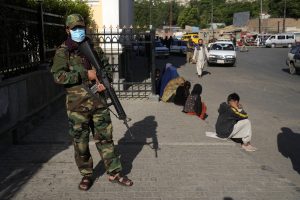Afghanistan may have fallen out of international headlines, but violent trends are once again on the rise. Our team at Afghan Peace Watch (APW), alongside colleagues at the Armed Conflict Location & Event Data Project (ACLED), have been tracking violent trends based on hundreds of incident reports recorded between September 2021 and March 2022. The report, Tracking Disorder During Taliban Rule in Afghanistan, provides one of the only comprehensive data-backed glimpses into the changing threat environment, based on 238 sources in all 34 provinces of Afghanistan.
The data is clear: While violence overall has decreased from the height of armed clashes between former Afghan government forces and the Taliban between May and August 2021, there has been a marked shift in violence against women, journalists, and educators that was simply not there under the previous government’s rule. Women have been forced to cover their faces and all but forbidden from public space. The Islamic State affiliate in Afghanistan (ISKP) has launched several high-profile terrorist attacks, fueling ethnic and religious tensions. Other trends in the data reveal a worrying rise in violence against former Afghan government forces, recently confirmed by the New York Times, and intense infighting between various Taliban factions and interests.
These factors present significant risks for renewed conflict in Afghanistan and the region, and underscore two important points. First, it is critical to continue data collection efforts despite the risks in order to accurately and independently assess violent trends under Taliban rule. Second, tracking trends on terrorist threats in Afghanistan may provide one of the only sources of credible information on resurgent terrorist activity, particularly transnational terrorist groups that already have an established foothold in the region, such as al-Qaida, the Pakistani Taliban (TTP), and Central Asian terrorist groups.
During the reporting period, APW recorded hundreds of incidents related to bombings, assassinations, abductions, and other forms of violence perpetrated by the Taliban and other terrorist groups. Using its exhaustive local networks and social media monitoring, APW is also working to map the leadership and interlinkages between these terrorist groups as they swap loyalties and engage in intense infighting, leading to new terrorist agendas and greater risks for the entire region.
Between August 2021 and March 2022, APW and ACLED recorded 33 incidents of Taliban infighting. Highly successful efforts made by the Taliban during their campaign last year to co-opt key actors in the north and other non-traditional Taliban strongholds seem particularly tenuous now, as there are inadequate spoils of war to placate these actors and their patronage networks. The Taliban government has coalesced around its real centers of gravity — the southern Kandahari leadership, the notorious eastern Haqqani network, and the emerging Ghazni-led intelligence apparatus — leaving little space for other ethnic and minority groups.
In the last few months alone, at least six new armed opposition groups have been announced opposing Taliban rule, many made up of former Afghan security forces (ANDSF) left behind and continually targeted for retribution by the Taliban, despite the general amnesty announced last year.
While the National Resistance Front (NRF) was the first group to engage in armed resistance against the Taliban under the leadership of the son of Ahmad Shah Massoud in Panjshir, several former ANDSF groups have also been more recently announced, including the Afghanistan Freedom Front (AFF) and the Pashtun-led Afghanistan Liberation Movement (ALM), demonstrating wide ranging and multiethnic opposition to the Taliban, including from within the Pashtun majority.
Between Taliban infighting, the plethora of emerging armed opposition groups, and the ever-changing terrorist landscape, violence in Afghanistan is set to rise with the fast-approaching summer fighting season. As the Taliban fail to placate their rank and file, or deliver on basic governance, the façade of a strong and united Taliban that governed effectively from the shadows is likely to dissipate. The reduction in violence visible in the data between September and December last year, interpreted by some as implicit evidence of local support for the Taliban, may be short lived.
Afghanistan fatigue remains high among international donors as fraught evacuation efforts and an impasse over girls’ access to education continue to dominate diplomatic overtures to the Taliban. The horrific events unfolding in Ukraine, which pose a direct and immediate threat to NATO, have also, understandably, diverted attention away from Afghanistan.
But just like the U.S. invasion of Iraq, and the collapse of the Soviet Union before that, history suggests that when the international community abandons Afghanistan, violence and extremism tend to simmer before they explode onto the international stage. The question now is has the international community learned its lesson or are we doomed to repeat the same mistake in Afghanistan again?

































